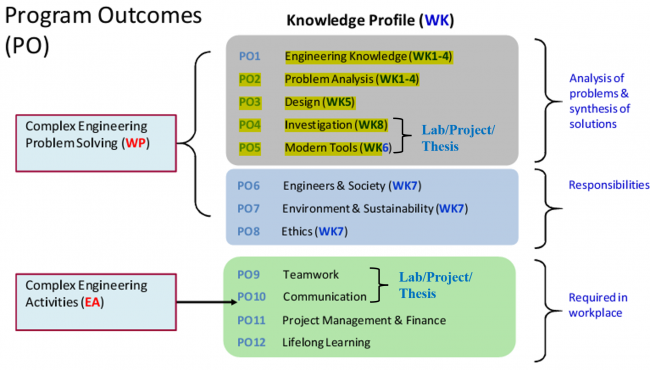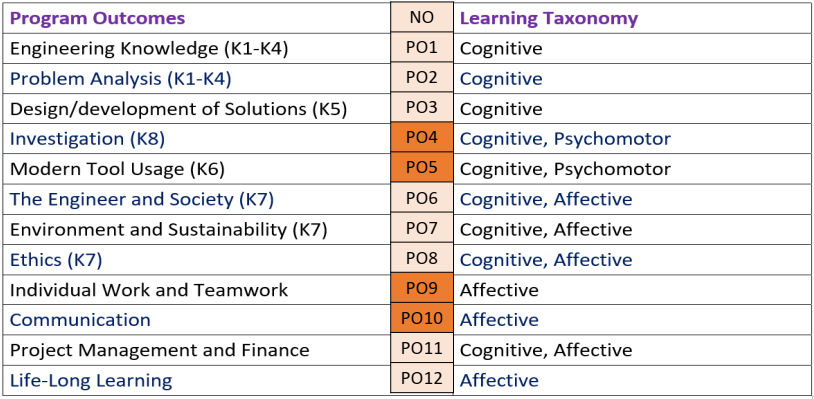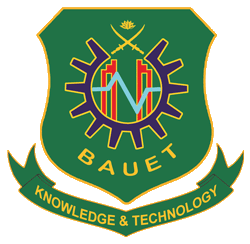Check List for course file
OBE Mapping V3
Course Instructor’s Feedback ICE 1222 Summer 21
OBE Maping Summer 2021
OBE Maping Fall 2020
OBE-Maping-Fall-2022
OBE-Maping-Summer-2022
OBE-Maping-Fall-2021

- Following POs may not be possible to assess through written exam:
- PO5: Modern Tool Usage
- PO9: Individual and Team Work
- PO10: Communication
- PO12: Life-long Learning
- Following POs can be assessed through lab courses
- PO4: Investigation – through software/hardware open-ended project
- PO5: Modern Tool Usage- through tools taught in Lab classes
- PO9: Individual and Team Work- through Group Projects
- PO10: Communication- through Viva, Project presentation, Written Reports etc
Five Recommended POs for Lab: PO4, PO5, PO9, PO10, PO12

Program Outcomes (POs), Knowledge Profile (WK), Complex Problem Solving (WP), and Complex Engineering Activities (EA)
Program Outcomes (POs):
| Sl. No | PO | Category | Description | ||
|
1 |
PO 1 |
Engineering Knowledge |
Apply knowledge of mathematics, natural science, engineering fundamentals and an engineering specialization as specified in K1 to K4 respectively to the solution of complex engineering problems. | ||
|
2 |
PO 2 |
Problem Analysis |
Identify, formulate, research literature and analyse complex engineering problems reaching substantiated conclusions using first principles of mathematics, natural sciences and engineering sciences. (K1 to K4) | ||
|
3 |
PO 3 |
Design/Development of Solutions |
Design solutions for complex engineering problems and design systems, components or processes that meet specified needs with appropriate consideration for public health and safety, cultural, societal, and environmental considerations. (K5) | ||
|
4 |
PO 4 |
Investigation |
Conduct investigations of complex problems using research-based knowledge (K8) and research methods including design of experiments, analysis and interpretation of data, and synthesis of information to provide valid conclusions. | ||
|
5 |
PO 5 |
Modern Tool Usage |
Create, select and apply appropriate techniques, resources, and modern engineering and IT tools, including prediction and modelling, to complex engineering problems, with an understanding of the limitations. (K6) | ||
|
6 |
PO 6 |
The Engineer and Society |
Apply reasoning informed by contextual knowledge to assess societal, health, safety, legal and cultural issues and the consequent responsibilities relevant to professional engineering practice and solutions to complex engineering problems. (K7) | ||
|
7 |
PO 7 |
Environment and Sustainability |
Understand and evaluate the sustainability and impact of professional engineering work in the solution of complex engineering problems in societal and environmental contexts. (K7) | ||
| 8 | PO 8 | Ethics |
|
||
| 9 | PO 9 | Individual and Team Work |
|
||
|
10 |
PO 10 |
Communication |
Communicate effectively on complex engineering activities with the engineering community and with society at large, such as being able to comprehend and write effective reports and design documentation, make effective presentations, and give and receive clear instructions. |
||
|
11 |
PO 11 |
Project Management and Finance | Demonstrate knowledge and understanding of engineering management principles and economic decision-making and apply these to one’s own work, as a member and leader in a team, to manage projects and in multidisciplinary environments. | ||
|
12 |
PO 12 |
Life Long Learning |
Recognize the need for, and have the preparation and ability to engage in independent and life-long learning in the broadest context of technological change. |
| No | PEO Statement | |
| PEO-1 | Successful professional and advanced degrees | Graduates of the program will have successful professional both in industry and government and/or will be able to successfully pursue advanced degrees. |
| PEO-2 | Apply knowledge Solve complex engineering problems | Graduates will apply analysis, design, optimization and implementation skills in order to formulate and solve Information and Communication Engineering and multidisciplinary complex engineering problems. |
| PEO-3 | Work collaboratively | Graduates will communicate effectively and work collaboratively maintaining high Year of ethical and professional values for improving the society. |
| PEO-4 | Take leadership positions | Graduates will take leadership positions in the industry and also initiate businesses offering innovative technical solutions to national and international problems. |
| Mission 1 | Education and Research |
| Mission 2 | collaborative and research |
| Mission 3 | technologically advanced intellectual leaders |
| Mission 3 | provide consultancy, advisory and testing services |
Knowledge Profile (WK/K)- CHARACTERISTIC
| WK1 | Natural Sciences | A systematic, theory-based understanding of the natural sciences applicable to the discipline | |
| WK2 | Mathematics | Conceptually-based mathematics, numerical analysis, statistics and formal aspects of computer and information science to support analysis and modelling applicable to the discipline | |
| WK3 | Engineering fundamentals | A systematic, theory-based formulation of engineering fundamentals required in the engineering discipline | |
| WK4 | Specialist knowledge | Engineering specialist knowledge that provides theoretical frameworks and bodies of knowledge for the accepted practice areas in the engineering discipline; much is at the forefront of the discipline. | |
| WK5 | Engineering design | Knowledge that supports engineering design in a practice area
|
|
| WK6 | Engineering practice | Knowledge of engineering practice (technology) in the practice areas in the engineering discipline | |
| WK7 | Comprehension | Comprehension of the role of engineering in society and identified issues in engineering practice in the discipline: ethics and the professional responsibility of an engineer to public safety; the impacts of engineering activity: economic, social, cultural, environmental and sustainability | |
| WK8 | Research literature | Engagement with selected knowledge in the research literature of the discipline | |
Complex Engineering Problem
| WP | Preamble | COMPLEX PROBLEMS have characteristic of WP1 and some or all of WP2 to WP7 | |
| WP1 | Depth of Knowledge | In-depth engineering knowledge at the level of one or more of WK3, WK4, WK5, WK6 or WK8 which allows a fundamental based, first principles analytical approach | |
| WP2 | Conflicting requirement | Wide-ranging or conflicting technical, engineering and other issues | |
| WP3 | Depth of analysis | no obvious solution and require abstract thinking, originality in analysis to formulate suitable models | |
| WP4 | Familiarity of issues | infrequently encountered issues | |
| WP5 | Extent of applicable codes | outside problems encompassed by standards and codes of practice for professional engineering | |
| WP6 | Extent of stakeholder | diverse groups of stakeholders with widely varying needs | |
| WP7 | Interdependence | high level problems including many component parts or sub-problems |
Complex Engineering Activities (Project based)
| Activities | Preamble | Complex activities means (engineering) activities or projects that have some or all of the following characteristics listed below |
| EA1 | Range of resources | Diverse resources (people, money, equipment, materials, information and technologies). |
| EA2 | Level of interaction | Require resolution of significant problems arising from interactions between wide ranging or conflicting technical, engineering or other issues. |
| EA3 | Innovation | Involve creative use of engineering principles and
research-based knowledge in novel ways. |
| EA4 | Consequences to society and the environment | Have significant consequences in a range of contexts, characterised by difficulty of prediction and mitigation. |
| EA5 | Familiarity | Can extend beyond previous experiences by applying
principles-based approaches. |






